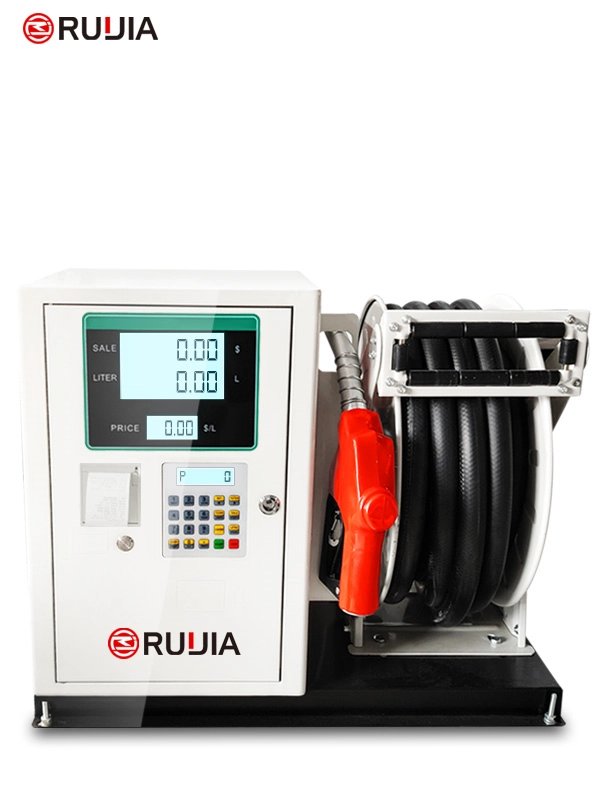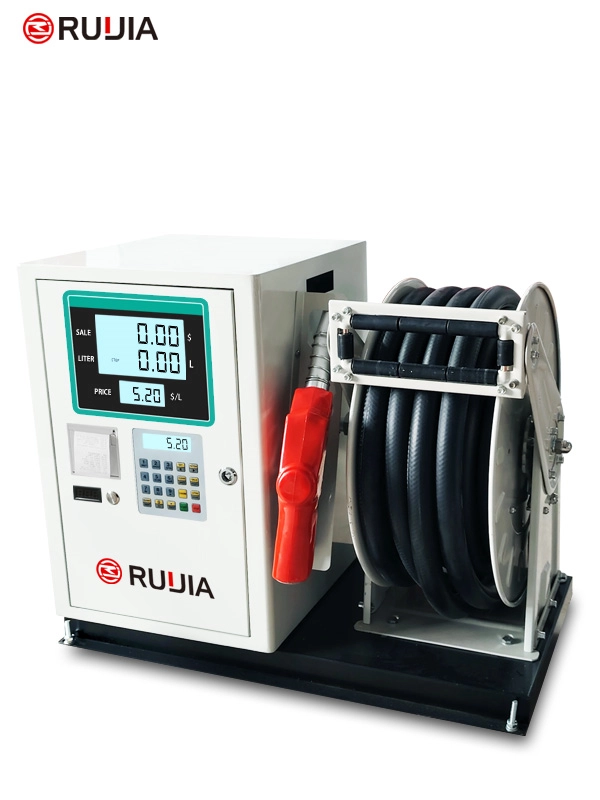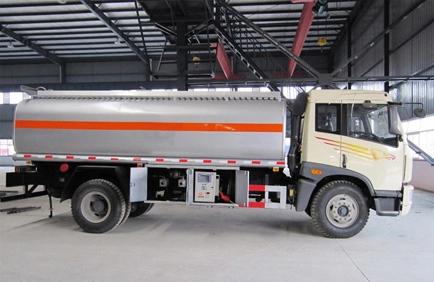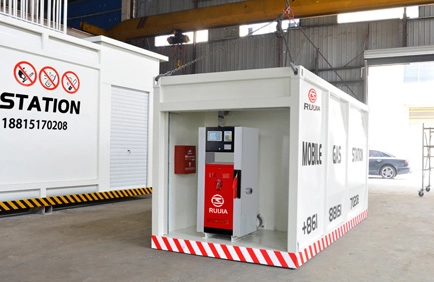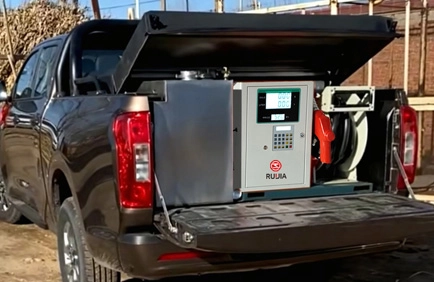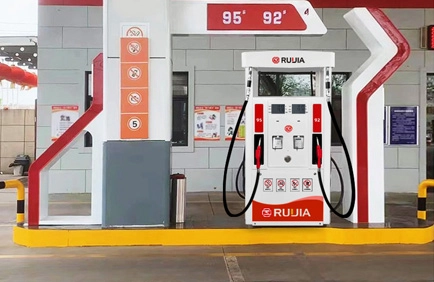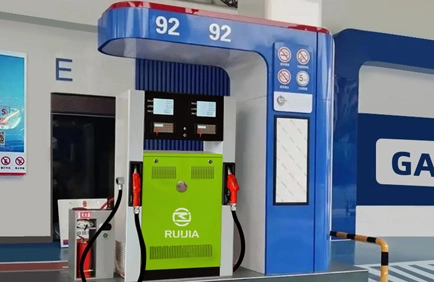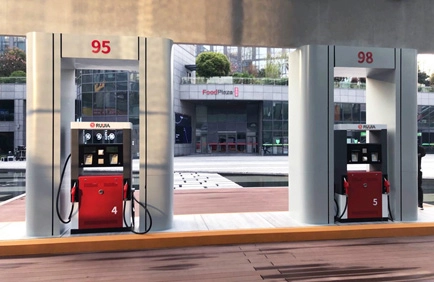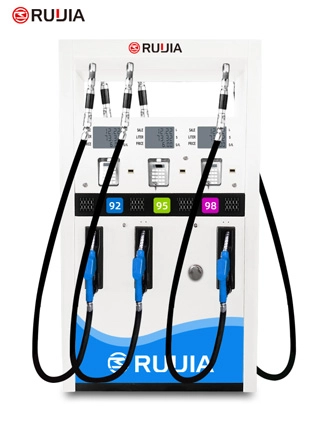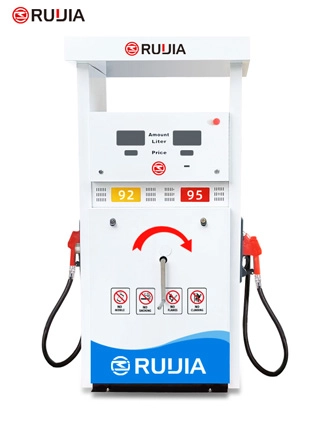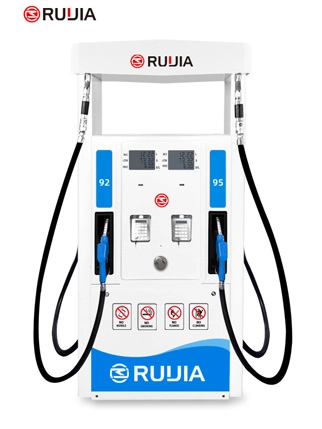Fuel Dispenser With Hose Reel
Product Parameter
- Product Name
- RJ66 Fuel Dispenser
- Brand Name
- Ruijia
- Product Size
- 400X380X550mm
- Flow Rate
- 5~80L/min
- Flow Meter
- 4- piston Flow Meter
- Pump
- Vane Pump
- Lcd Display
- 886 or 664
- Temperature
- -25°C~ +55°C
- Pressure
- 0.3MPa
- Accuracy
- ±0.3%
- Voltage
- AC220V,DC12V,DC24V
- Suction Distance
- 6m(vertical), 20m(horizontal)
- Power
- 550W
- Medium
- Gasoline, Diesel, Kerosene
Product Configuration
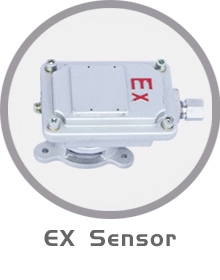

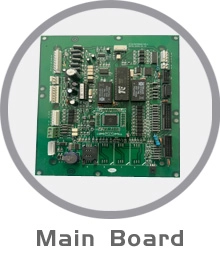
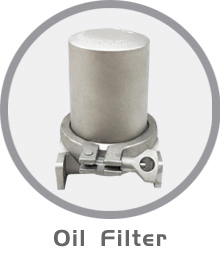
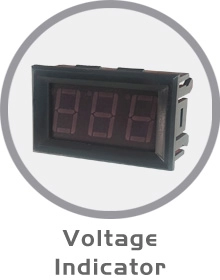
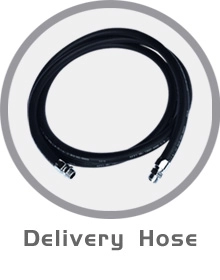
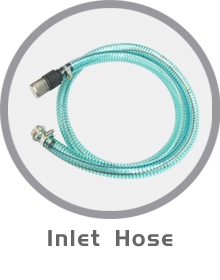
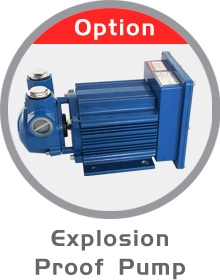

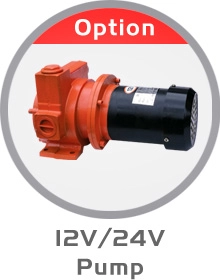
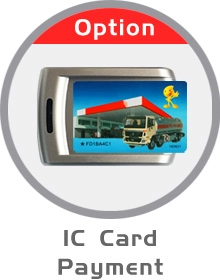
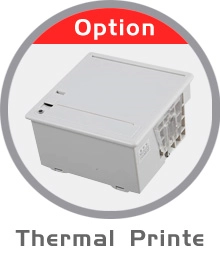
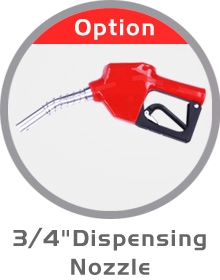
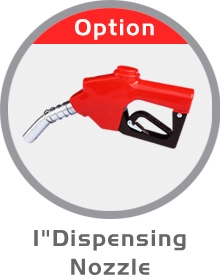
Our Certification

What is a Fuel Dispenser With Hose Reel?
A fuel dispenser with a hose reel is a specialized fueling system designed to deliver liquid fuel (such as gasoline, diesel, or biodiesel) to vehicles, machinery, or equipment while incorporating a hose reel for efficient storage and deployment of the fuel hose. This combination of a fuel dispenser and a hose reel enhances portability, convenience, and operational efficiency, making it a critical tool in industries where traditional, fixed fueling stations are unavailable or impractical. Whether in remote construction sites, military operations, disaster relief efforts, or large-scale events, a fuel dispenser with a hose reel provides a flexible solution to meet fueling demands in dynamic environments.
This article provides a comprehensive exploration of fuel dispensers with hose reels, covering their definition, historical evolution, key components, functionality, applications, advantages, challenges, and future trends. By examining the role of these devices in modern fuel distribution, we gain insight into how they bridge the gap between traditional fueling systems and the evolving needs of industries that rely on mobility, efficiency, and adaptability.
Definition and Purpose
A fuel dispenser with a hose reel is a self-contained or semi-permanent system that allows for the transfer of liquid fuel from a storage tank to vehicles or equipment. The hose reel is an integral component of this system, designed to store and deploy the fuel hose in a compact and organized manner. Unlike stationary fuel dispensers found at gas stations, which require permanent infrastructure, a fuel dispenser with a hose reel is engineered to be portable, adaptable, and efficient in diverse environments.
The primary purpose of a fuel dispenser with a hose reel is to provide fueling capabilities in locations where traditional fueling stations are unavailable or impractical. This includes remote construction sites, military operations, disaster relief efforts, and large-scale events where fuel accessibility is essential. By integrating a hose reel, these dispensers eliminate the need for complex piping systems and allow for easy transportation and deployment, making them ideal for temporary or mobile fueling needs.
The hose reel itself is a spool or reel that holds the fuel hose, enabling it to be wound tightly for storage and unwound for use. This design not only simplifies the management of the hose but also reduces the risk of damage, kinking, or tangling, which can occur with traditional fueling setups. Additionally, the hose reel often includes mechanisms for automatic retraction, ensuring that the hose is neatly stored after use.
Historical Evolution of Fuel Dispensers with Hose Reels
The concept of mobile fuel dispensing has its roots in the early 20th century, when the demand for fuel in remote and industrial areas outpaced the availability of fixed stations. Initially, fuel was transported in barrels or drums, requiring manual pouring and posing risks of spills and inefficiency. As technology advanced, the need for more reliable and efficient solutions led to the development of mobile fuel dispensers.
The first mobile fuel dispensers were simple, manually operated systems that used hand pumps to transfer fuel from storage tanks to vehicles. These early models were primarily used in military and agricultural settings, where fuel access was critical but infrastructure was limited. Over time, the integration of electric pumps, digital controls, and automated systems transformed mobile dispensers into sophisticated, user-friendly devices.
The addition of a hose reel to fuel dispensers emerged as a response to the challenges of managing long, unwieldy hoses in mobile applications. Early versions of hose reels were manually operated, requiring users to wind the hose by hand. However, as technology advanced, motorized hose reels were introduced, allowing for automatic retraction and improved efficiency. These innovations made fuel dispensers with hose reels increasingly popular in industries where mobility and convenience were paramount.
By the late 20th century, mobile fuel dispensers with hose reels had become a standard tool in sectors such as construction, mining, and logistics. The 1980s and 1990s saw the introduction of modular fueling units that could be quickly deployed and reconfigured for different applications. Today, fuel dispensers with hose reels are equipped with advanced technologies, including IoT (Internet of Things) integration, smart metering systems, and environmental compliance features, making them more efficient, safer, and environmentally friendly.
Key Components of a Fuel Dispenser With Hose Reel
A fuel dispenser with a hose reel is a complex system composed of several interdependent components, each designed to ensure safe and efficient fuel delivery. These components include:
1. Fuel Storage Tank
The fuel storage tank is the heart of the system, holding the liquid fuel before it is dispensed. These tanks are typically made of durable materials like stainless steel or reinforced plastic to prevent leaks and corrosion. They are designed to withstand the rigors of transportation and varying environmental conditions. Some models include insulated tanks to maintain fuel temperature in extreme climates.
2. Pump System
The pump is responsible for moving fuel from the storage tank to the vehicle. Mobile fuel dispensers often use positive displacement pumps or centrifugal pumps, depending on the fuel type and required flow rate. These pumps are equipped with pressure regulators to maintain consistent fuel pressure and prevent overflows.
3. Hose Reel
The hose reel is the defining feature of this system, designed to store and deploy the fuel hose. It consists of a spool or reel that winds the hose tightly for storage and unwinds it for use. Modern hose reels may include automatic retraction mechanisms, which allow the hose to be retracted without manual effort. This feature not only simplifies the process but also reduces the risk of damage or tangling.
4. Nozzle and Shut-Off Valve
The nozzle is the point of contact between the dispenser and the vehicle’s fuel tank. It includes a suction valve that automatically stops the flow of fuel when the tank is full, preventing spills and overfilling. Diesel nozzles are typically larger and heavier than gasoline nozzles due to the higher viscosity of diesel fuel.
5. Flow Meter
A flow meter measures the volume of fuel being dispensed and ensures accurate billing. Modern mobile dispensers often use digital flow meters with electronic sensors to provide precise readings, reducing the risk of fraud and ensuring fair pricing.
6. Vapor Recovery System
To minimize environmental impact, many fuel dispensers with hose reels incorporate vapor recovery systems that capture fuel vapors during the dispensing process. These systems route the vapors back to the storage tank, reducing air pollution and complying with environmental regulations.
7. Filters
Filters remove impurities such as dirt, water, and sediment from the fuel before it reaches the vehicle. This ensures clean fuel delivery and protects engines from damage.
8. Control Panel and Payment Terminal
The control panel allows users to select the type of fuel (e.g., regular, premium, diesel) and monitor fuel volume and cost. Modern dispensers are equipped with touchscreen interfaces, card readers, and mobile payment options for convenience. Some models also include loyalty program integration and real-time fuel pricing.
9. Safety Features
Safety is a top priority in fuel dispensers with hose reels. Features such as anti-static grounding, leak detection systems, and emergency shut-off valves prevent accidents and ensure compliance with industry standards. Additionally, non-spill nozzles and vapor recovery systems further enhance safety.
10. Transportation Infrastructure
Mobile fuel dispensers are often mounted on trailers, trucks, or portable platforms, allowing them to be easily transported to different locations. These units are designed for durability, with reinforced frames and weather-resistant enclosures.
How a Fuel Dispenser With Hose Reel Works
The operation of a fuel dispenser with a hose reel involves a series of coordinated steps to ensure safe and efficient fuel delivery. Here’s a detailed breakdown of the process:
1. Fuel Supply
Fuel is stored in the storage tank and transported to the site where it is needed. The tank is connected to the dispenser via a network of pipes and valves. A submersible pump or tank pump located in the storage tank ensures a steady flow of fuel to the dispenser.
2. User Interaction
When a driver approaches the dispenser, they select the desired fuel type (e.g., regular, premium, diesel) using the control panel. The dispenser’s display shows the price per gallon and the total cost based on the selected fuel.
3. Hose Deployment
The driver removes the hose from the hose reel and connects it to the vehicle’s fuel tank. The hose reel’s automatic retraction mechanism ensures that the hose is neatly stored after use, reducing the risk of damage or tangling.
4. Fuel Dispersion
The pump draws fuel from the storage tank and pushes it through the hose. A flow meter measures the volume of fuel being dispensed, ensuring accuracy. The driver can monitor the amount of fuel and total cost on the digital display.
5. Automatic Shut-Off
When the vehicle’s tank is full, the suction valve in the nozzle automatically stops the flow of fuel, preventing overfilling and spills.
6. Vapor Recovery
As fuel is dispensed, the vapor recovery system captures excess vapors, which are then routed back to the storage tank. This reduces air pollution and ensures compliance with environmental regulations.
7. Payment and Shutdown
Once the driver completes the transaction, they pay for the fuel using a credit card, mobile payment app, or cash. The dispenser then shuts off the fuel flow, and the system updates the payment terminal.
This process is repeated for each vehicle, allowing multiple drivers to fuel their vehicles simultaneously without waiting for an attendant.
Types of Fuel Dispensers With Hose Reels
Fuel dispensers with hose reels come in various designs to suit different needs and environments. Some common types include:
1. Trailer-Mounted Units
These dispensers are mounted on trailers and can be towed to different locations. They are ideal for temporary fueling operations, such as construction sites or event venues. Trailer-mounted units are often equipped with large storage tanks and high-capacity pumps to handle heavy fueling demands.
2. Vehicle-Mounted Units
Mobile dispensers integrated into trucks or other vehicles allow for on-the-go fueling. These units are commonly used in military, emergency response, and remote industrial applications. Vehicle-mounted dispensers are designed to withstand harsh conditions and ensure operational readiness.
3. Portable Units
Smaller, lightweight dispensers that can be carried or wheeled to the desired location. These are suitable for small-scale operations, such as refueling lawn mowers, small generators, or recreational vehicles.
4. Modular Systems
These dispensers consist of interchangeable components that can be configured for different fuel types and volumes. They are highly flexible and adaptable to changing operational needs, making them ideal for industries with diverse fueling requirements.
5. Hybrid Systems
Combining traditional fuel dispensing with electric vehicle (EV) charging capabilities, hybrid mobile dispensers cater to a broader range of energy needs. These systems are particularly useful in areas transitioning to renewable energy sources.
6. Emergency Fuel Units
Designed for disaster relief or military operations, these dispensers prioritize speed, reliability, and durability in extreme conditions. They are equipped with redundant systems and backup power sources to ensure continuous operation.
Applications of Fuel Dispensers With Hose Reels
Fuel dispensers with hose reels are used in a wide range of industries and scenarios, including:
1. Construction and Mining
In remote or rugged environments, mobile dispensers provide fuel for heavy machinery, trucks, and equipment. They are essential for projects where access to fixed fueling stations is limited.
2. Military Operations
Mobile fuel dispensers are critical for military logistics, enabling the rapid refueling of vehicles, aircraft, and generators in the field. They are designed to withstand harsh conditions and ensure operational readiness.
3. Disaster Relief
During natural disasters or emergencies, mobile dispensers provide fuel for rescue vehicles, generators, and emergency equipment. Their portability allows for quick deployment to affected areas.
4. Event and Festival Management
Large-scale events such as concerts, sports games, and festivals often use mobile dispensers to fuel vehicles, generators, and other equipment. This ensures uninterrupted operations and minimizes downtime.
5. Agriculture and Farming
Farmers rely on mobile dispensers to fuel tractors, harvesters, and other machinery. These units are particularly useful in rural areas where fixed fueling stations are scarce.
6. Remote Communities
In isolated regions with limited infrastructure, mobile dispensers provide a lifeline for fueling vehicles and generators. They are often used in conjunction with renewable energy systems to ensure energy security.
7. Marine and Offshore Operations
Mobile dispensers are used to refuel boats, offshore platforms, and marine equipment. They are designed to operate in challenging maritime environments.
Advantages of Fuel Dispensers With Hose Reels
Fuel dispensers with hose reels offer numerous benefits that make them a valuable asset in various industries. Key advantages include:
1. Flexibility and Portability
Their ability to be transported to different locations makes them ideal for temporary or remote operations. This flexibility is particularly useful in dynamic environments where fueling needs change frequently.
2. Cost-Effectiveness
By eliminating the need for permanent infrastructure, mobile dispensers reduce capital expenditures. They are also cost-effective for short-term projects or seasonal operations.
3. Accessibility
Mobile dispensers provide fuel access in areas where traditional stations are unavailable, ensuring that critical operations can continue without interruption.
4. Operational Efficiency
With features like automated shut-off valves and flow meters, mobile dispensers enhance fueling efficiency and reduce the risk of human error.
5. Environmental Benefits
Advanced models incorporate vapor recovery systems and low-emission technologies to minimize environmental impact. This aligns with global efforts to reduce fuel waste and air pollution.
6. Scalability
Mobile dispensers can be customized to handle different fuel types and volumes, making them adaptable to a wide range of applications.
Challenges and Considerations
While mobile fuel dispensers with hose reels offer significant advantages, they also present certain challenges:
1. Maintenance and Durability
Mobile dispensers are exposed to harsh conditions, requiring regular maintenance to ensure optimal performance. Components like pumps and filters must be inspected and replaced periodically.
2. Safety Risks
Fuel is flammable, so strict safety protocols must be followed to prevent leaks, spills, or fires. Dispensers are equipped with anti-static grounding and leak detection systems to mitigate risks.
3. Regulatory Compliance
Mobile dispensers must meet local and international standards for fuel handling, environmental protection, and electrical safety. Compliance with these regulations is critical for both legal and operational reasons.
4. Training and Operation
Proper training is essential for users to operate mobile dispensers safely and efficiently. This includes understanding safety procedures, fueling protocols, and emergency response measures.
5. Initial Investment
While mobile dispensers can save costs in the long term, the initial investment for purchasing and setting up the system can be high. However, the return on investment is often justified by the flexibility and efficiency they provide.
Future Trends and Innovations
The future of fuel dispensers with hose reels is likely to be shaped by advancements in technology and changing consumer demands. Key trends include:
1. Smart and Connected Systems
The integration of IoT (Internet of Things) technology will enable mobile dispensers to collect and transmit real-time data on fuel levels, usage patterns, and maintenance needs. This will enhance operational efficiency and reduce downtime.
2. Renewable Energy Integration
As the world transitions to cleaner energy sources, mobile dispensers may incorporate hybrid systems that combine traditional fueling with electric vehicle (EV) charging or hydrogen fueling capabilities.
3. Sustainability Initiatives
Future dispensers may feature carbon capture technology, biodegradable fuels, and energy-efficient pumps to further reduce their environmental footprint.
4. Autonomous Operation
Advances in artificial intelligence (AI) and automation could lead to fully autonomous mobile dispensers capable of self-fueling, monitoring, and maintenance.
5. Enhanced User Experience
Improvements in user interface design, multilingual support, and interactive guides will make mobile dispensers more accessible to a global audience.
Conclusion
A fuel dispenser with a hose reel is a vital tool in modern fuel distribution, offering a flexible, efficient, and cost-effective solution for fueling vehicles and equipment in diverse environments. Its design, functionality, and applications reflect the evolving needs of industries ranging from construction and agriculture to military and disaster relief. By addressing the limitations of traditional fueling stations, mobile dispensers ensure that fuel is accessible where and when it is needed most.
As technology continues to advance, fuel dispensers with hose reels will likely become even smarter, safer, and more sustainable, playing an increasingly important role in the global energy landscape. Whether used for emergency response, industrial operations, or remote communities, these devices exemplify the power of innovation in meeting the challenges of a rapidly changing world. By prioritizing adaptability, efficiency, and environmental responsibility, fuel dispensers with hose reels will remain a cornerstone of fuel distribution for years to come.
